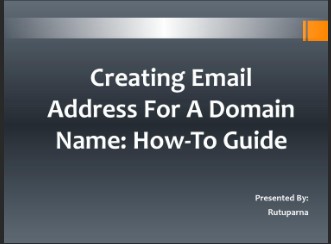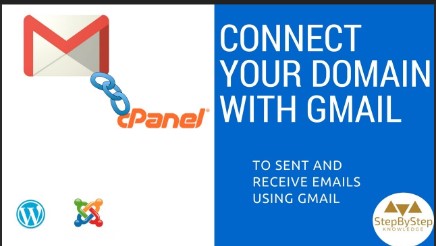Creating An Email Address With A Domain Name
In today’s digital age, a professional email address is more than just a means of communication; it’s a digital business card, a representation of your brand, and a cornerstone of credibility in the online world.
As we delve into the realm of email addresses with domain names, let’s explore the manifold benefits awaiting those who embrace this digital evolution.
The Importance of a Professional Email Address
Your email address is often the first point of contact between you and potential clients, employers, or collaborators. A professional email address instills trust and confidence, signaling to recipients that you are serious about your online presence and professional endeavors.
It serves as a reflection of your professionalism and attention to detail, setting the tone for your interactions and leaving a lasting impression.
Benefits of Having an Email Address with a Domain Name
Beyond mere professionalism, having an email address with a domain name offers a plethora of advantages. Firstly, it enhances brand recognition and reinforces your brand identity with every email sent.
Secondly, it lends a sense of credibility and legitimacy to your online presence, distinguishing you from generic, free email providers. Moreover, it affords greater control and flexibility over your email infrastructure, empowering you to tailor your email experience to suit your unique needs and preferences.
Choosing the Right Domain Name
Understanding Domain Name Extensions
When selecting a domain name for your email address, it’s essential to grasp the significance of domain name extensions. These extensions, such as .com, .net, or .org, not only dictate the web address of your email but also convey valuable information about your brand or organization.
While .com remains the gold standard for commercial entities, newer extensions like .io or .co offer a fresh perspective and niche appeal.
Tips for Selecting a Domain Name for Your Email Address
In the vast expanse of cyberspace, choosing the perfect domain name can be a daunting task. However, by adhering to a few guiding principles, you can navigate this digital landscape with confidence and clarity.
Firstly, prioritize brand consistency by aligning your domain name with your existing brand identity and messaging. Secondly, ensure relevance to your business or personal brand, opting for a name that reflects your niche, industry, or area of expertise.
Lastly, steer clear of complex or obscure names that are prone to spelling errors or misinterpretation, opting instead for simplicity and clarity.
Setting Up Your Email Hosting Provider
Comparing Email Hosting Providers
With a myriad of email hosting providers vying for your attention, it’s crucial to conduct thorough research and comparison before making a decision.
Consider factors such as pricing, storage space, security features, and user interface when evaluating different providers. Whether you opt for a well-established provider like Google Workspace or a niche player catering to specific needs, choose a provider that aligns with your requirements and aspirations.
Factors to Consider When Choosing an Email Hosting Provider
Pricing is often a primary consideration when selecting an email hosting provider, especially for budget-conscious individuals or small businesses.
However, it’s essential to strike a balance between affordability and functionality, ensuring that you receive value for your investment. Additionally, consider factors such as storage space, which dictates the capacity of your email inbox and the volume of messages you can store.
Security features are another critical aspect to evaluate, encompassing measures such as encryption, spam filtering, and two-factor authentication. Lastly, prioritize user interface and ease of use, as an intuitive platform can streamline your email management tasks and enhance productivity.
Configuring Your Domain Name for Email
Accessing Your Domain Name Registrar’s Control Panel
Before you can embark on configuring your domain name for email, you’ll need to access your domain name registrar’s control panel.
This control panel serves as the gateway to your domain’s settings, allowing you to make changes and adjustments as needed. Whether you’re using popular registrars like GoDaddy or Namecheap or a lesser-known provider, the process of accessing the control panel remains relatively consistent.
Adding MX Records for Email Hosting
MX records, short for Mail Exchange records, are essential components of your domain’s DNS settings, directing incoming email traffic to the appropriate email servers.
To add MX records for email hosting, navigate to your domain registrar’s control panel and locate the DNS management section.
From there, add the MX records provided by your email hosting provider, specifying the priority and destination for each record. Once saved, these records will ensure seamless delivery of emails to your domain’s inbox.
Verifying Domain Ownership
Before you can start sending and receiving emails from your domain name, you’ll need to verify ownership of the domain. This verification process typically involves adding a TXT record to your domain’s DNS settings or uploading a verification file to your website’s root directory.
Once verified, you’ll gain access to additional features and functionalities within your email hosting provider’s platform, ensuring a smooth and secure email experience.
Setting Up SPF, DKIM, and DMARC Records for Enhanced Email Security
In addition to MX records, SPF (Sender Policy Framework), DKIM (DomainKeys Identified Mail), and DMARC (Domain-based Message Authentication, Reporting, and Conformance) records play crucial roles in bolstering the security of your email infrastructure.
SPF allows email servers to verify that incoming messages originate from authorized senders, preventing spoofing and phishing attacks. DKIM adds an extra layer of authentication by attaching digital signatures to outgoing emails, verifying their integrity and authenticity.
DMARC provides further protection by enabling domain owners to specify how email providers should handle messages that fail SPF and DKIM checks, reducing the risk of unauthorized use of your domain name for malicious purposes.
Creating Email Accounts
Steps to Create Email Accounts with Your Hosting Provider
Once you’ve configured your domain name for email, it’s time to create email accounts for yourself and any additional users or team members. Begin by logging into your email hosting provider’s platform and navigating to the email account management section.
From there, follow the prompts to create new email accounts, specifying usernames, and passwords, and display names as desired. Depending on your provider, you may have the option to set up email aliases, forwarders, or distribution lists to streamline communication and collaboration.
Assigning Usernames and Passwords
When assigning usernames and passwords for your email accounts, prioritize security and complexity to minimize the risk of unauthorized access or data breaches.
Avoid using easily guessable passwords or common phrases, opting instead for a combination of letters, numbers, and special characters.
Consider implementing multi-factor authentication (MFA) for an added layer of protection, requiring users to verify their identity via SMS code, authenticator app, or biometric scan before accessing their email accounts.
Managing Multiple Email Accounts for Different Purposes or Team Members
For individuals or organizations with diverse communication needs, managing multiple email accounts can be a logistical challenge. However, with the right approach and tools, you can streamline this process and maintain control over your email ecosystem.
Consider using email aliases or subdomains to categorize emails based on their intended recipients or purposes. Additionally, leverage email forwarding and filtering rules to automate the sorting and prioritization of incoming messages, ensuring that important communications receive prompt attention while minimizing distractions and clutter.
Accessing Your Email
Using Webmail Interfaces Provided by Your Hosting Provider
One of the most convenient ways to access your email is through the webmail interface provided by your hosting provider.
Whether you’re using a desktop computer, laptop, or mobile device, simply login to your email account via your web browser to access your inbox, compose new messages, and manage your email settings. Webmail interfaces typically offer a user-friendly experience with features such as drag-and-drop functionality





